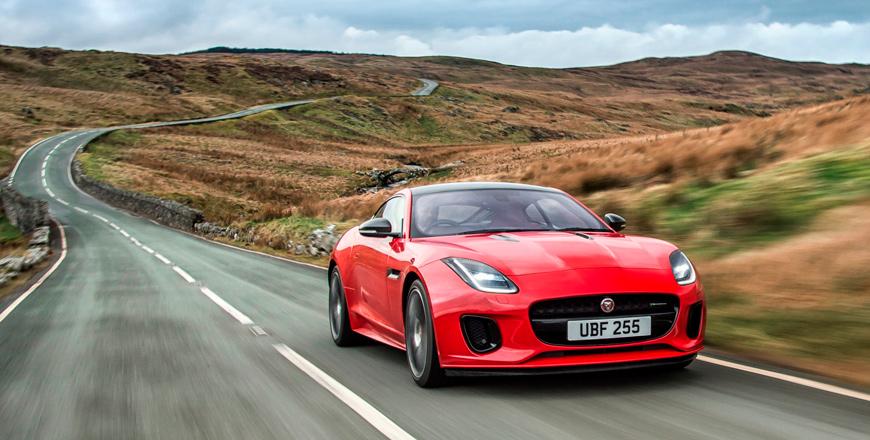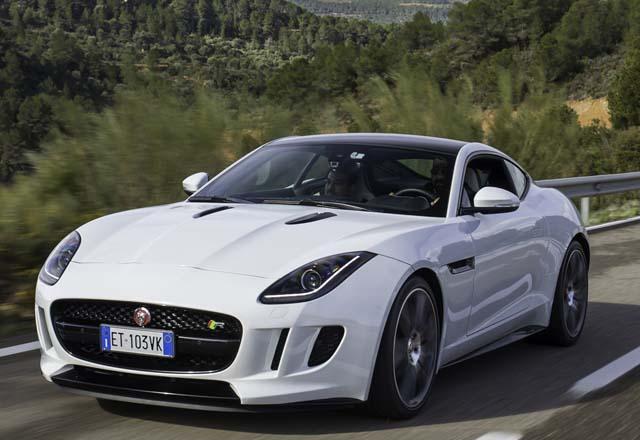You are here
Jaguar F-Type Coupe 2.0 R-Dynamic: When less is more
By Ghaith Madadha - Jan 07,2019 - Last updated at Jan 07,2019

Photo courtesy of Jaguar
An entry-level addition to the British car maker’s two-seat premium sports car line, the 2-litre four-cylinder version of the Jaguar F-Type Coupe is a more accessible, affordable and frugal alternative to the existing 3-litre V6 and 5-litre V8 incarnations.
Hot on the heels of the most powerful SVR skunkworks F-Type iteration, the four-pot 2.0 gives away a substantial 271BHP, but is also a significant 180kg lighter, more nimble and often is more fun to drive, especially in daily driving situations.
Arriving as part of a subtle F-Type mid-life facelift and model revision, the more economical turbocharged 2.0 model is visually a little different, but delivers a somewhat different driving characteristic of the previous 335BHP entry-level V6 model.
Positioned close to the lesser of an expanded three supercharged V6 engine F-Type selection, the 2.0’s performance is a little behind the entry-level V6, but is conversely more fuel efficient.
In terms of character the 2.0 places more emphasis on low-end and mid-range muscle and versatility than the supercharged V6’s sweeping and higher-revving delivery.
A flair for the dramatic
Little changed in design, the revised F-Type models circa 2018 retains the same svelte and feline lines, curves and profile, long bonnet and pert rear as when it first launched back in 2013.
Similarly unchanged are the F-Type’s wide, hungry and recessed mesh grille and moody, slim rear lights.
However, the updated model does ditch the original’s gill-like side intakes for a single opening mesh design, and also features more variation in its front bumper and lower lip design to differentiate between models and specifications, as well as full LED headlights.
Driven in the more aesthetically aggressive R-Design trim, with a large fixed rear wing for dramatic posture and improved aerodynamic down-force, and large 20-inch alloys with staggered 255/35ZR20 front and 295/30ZR20 rear tyres for added traction, the entry-level 2.0 looks about as menacingly assertive as the full fat SVR version.
More planted into the tarmac at speed and through fast corners with the larger tyres and fixed rear wing, the F-Type Coupe 2.0’s smaller and lighter turbocharged 2-litre 4-cylinder engine does however make it more nimble, agile and eager into corners as well as tidier when making sudden direction changes.
Mid-range punch
The rear wheels progress through a slick, smooth and quick shifting 8-speed automatic gearbox with a broad range of ratios for performance, efficiency and versatility with escalating responsive auto and manual paddle-shift modes.
The F-Type 2.0, however, is not offered with all-wheel-drive or manual gearbox options as some other F-Type models.
Producing 296BHP at 5500rpm and 295lb/ft torque throughout a broad and accessible 1500-4500rpm plateau, the F-Type’s new Ingenium family four-cylinder engine allows for brisk performance, including 0-100km/h acceleration in just 5.7-seconds, a 250km/h top speed and modest 7.2l/100km combined cycle fuel efficiency.
The car is responsive from standstill with its quick spooling exhaust gas-driven turbocharger, if not as immediate off the line and consistent from tickover to redline as its larger displacement and mechanically-driven supercharged sister models.
The F-Type 2.0, however, is formidably punchy, eager and a genuinely swift car.
The car is effortlessly flexible as it accumulates speed when driving on its big brawny and generously broad mid-range torque sweet spot, whether overtaking or cruising at speed, however, the four-cylinder is a distinctly lower revving machine than other F-Types.
Agile ability
Despite its lower revving character, the F-Type is one of the most rewarding and fun F-Type models around, which allows one to enjoy pushing it hard without going too fast, and all the while enjoying its growling and churning acoustics.
In general, it is nippy, maneuvreable and eager turning into corners with quick, direct and well-weighted steering delivering a meaty yet more delicately nuanced feel for the road than much of the competition.
The F-Type 2.0 controls body lean well through the corners and remains buttoned down over road imperfections.
A front-engine rear-drive sports coupe with near perfect weighting and a relatively short wheelbase, the F-Type 2.0 delivers agile and adjustable handling with a more purist appeal than all-wheel-drive F-Types.
The F-Type’s rear however, can be gradually coaxed out slightly to tighten a cornering line. However, its stability controls keep things well in check, and while a limited-slip differential would have made a nice addition for such situations, the F-Type does however feature selective brake-based torque vectoring for added agility and stability.
Classy, cosy and comfortable
Settled, reassuringly stable and refined at speed and in town, the F-Type’s ride is smooth and somewhat firm over bumps, but otherwise its fixed rate double wishbone suspension fluently flows with road textures.
Cosy and comfortable, the 2-seat F-Type’s cabin is classy, sporty and driver focused with a thick steering wheel, lots of lush leathers and metals, soft textures and an intuitive layout.
Visibility is good in front, but with thick rear pillars, big haunches, a low roof and a small rear hatch, one tends to use the reversing camera for improved rear visibility. Meanwhile boot space accommodates luggage for two for a weekend excursion.
Driving position is meanwhile supportive, alert and more comfortable, with slimmer, more ergonomically contoured standard R-Dynamic seats proving more comfortable for larger and taller drivers than the SVR model’s sportier seats.
Well-kitted with safety, comfort, infotainment and driver assistance systems, one found the F-Type’s blind spot warning system particularly useful and its infotainment touchscreen user-friendly.
However, though convenient, the standard electric opening rear tailgate is perhaps an unnecessary luxury and small weight gain for so sporty a car with lightweight aluminum construction.
Jaguar F-Type Coupe 2.0 R-Dynamic
Engine: 2-litre, turbocharged, in-line 4-cylinders
Bore x stroke: 83 x 92.3mm
Compression ratio: 9.5:1
Valve-train: 16-valve, DOHC, variable timing, direct injection
Gearbox: 8-speed automatic, rear-wheel-drive
Ratios: 1st 4.714; 2nd 3.143; 3rd 2.106; 4th 1.667; 5th 1.285; 6th 1.0; 7th 0.839; 8th 0.667
Reverse / final drive ratios: 3.295 / 3.55
Power, BHP (PS) [kW]: 296 (300) [221] @5500rpm
Specific power: 148.2BHP/litre
Power-to-weight: 194.1BHP/tonne
Torque, lb/ft (Nm): 295 (400) @1500-4500rpm
Specific torque: 200.3Nm/litre
Torque-to-weight: 262.3Nm/tonne
0-100km/h: 5.7-seconds
Top speed: 250km/h
Fuel economy, combined: 7.2-litres/100km
CO2 emissions, combined: 163g/km
Fuel capacity: 63-litres
Length: 4482mm
Width: 1923mm
Height: 1310mm
Wheelbase: 2622mm
Track, F/R: 1597/1649mm
Boot capacity, min/max: 310/408-litres
Unladen weight: 1525kg
Suspension, F/R: Double wishbones
Steering: Electric-assisted rack & pinion
Turning circle: 10.7-meters
Brakes, F/R: 355/325mm ventilated discs
Brake calipers, F/R: 2-/1-piston
Tyres, F/R: 255/35ZR20 / 295/30ZR20
Related Articles
A long-awaited, stylishly slinky and swift spiritual sports car successor to Jaguar’s iconic 1961-74 E-Type, the F-Type was much-feted upon
Using a nomenclature intended to mark its lineage from and position as belated successor to the classic E-Type, Jaguar’s sultry soft top is the Britsh marque’s first return to the sports car segment since the 1960s E-Type, and so bears the F-Type designation. In between the two, Jaguar’s other sporting models, were the larger XK and XJS grand tourer coupes, while the limited production 1990-92 XJR-15 and 1992-94 XJ220 were, respectively, a road-going racer and an all-out hyper-car. Capturing much of its distant predecessor’s glamour, chic and feel-good fun factor, the F-Type is intended to instill the modern Jaguar brand with such sporting authenticity.
Sportier and arguably even better looking than its convertible sister launched last year, this year’s Jaguar F-Type Coupe is a classy, quick and beguilingly beautiful two-seat sports car that consolidates the resurgent British brand’s sporting credentials.














